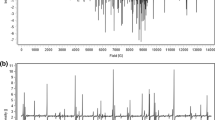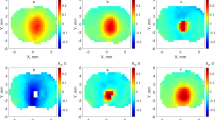Abstract
By using a narrow single electron spin resonance (ESR) line agent, triarylmethyl, tris(8-carboxy-2,2,6,6-tetrahydroxyethylbenzo[1,2-d:4,5-d′] bis(1,3)dithiole-4-yl)methyl sodium salt (TAM OX063), pulsed longitudinally detected ESR (LODESR) measurements of a phantom or the chest of a living mouse at the operating frequency of ca. 300 MHz were taken and the effective longitudinal relaxation time (T *1 ) was estimated for oximetry. Under irradiation of a pair of π-pulses with a variable interval between pulses (τ), in-phase LODESR signal intensities were obtained from the phantoms containing TAM dissolved in a physiological saline solution at a concentration of 1 mM and various concentrations of oxygen. TheT *1 of the phantom was calculated from the plotted curve of the LODESR signal intensity against τ. It was found that the reciprocal ofT *1 , i.e., the longitudinal relaxation rate, increased with the concentration of oxygen. In vivo pulsed LODESR measurements of the chest of living mice that had received a TAM injection via the intraperitoneal route were made. While the LODESR measurements were being made, the mice in one group breathed normal air and those in another group breathed 100% oxygen. It was found that the longitudinal relaxation rate of the mice breathing 100% oxygen was significantly greater than that of mice breathing normal air, indicating that breathing 100% oxygen elevates the thoracic longitudinal relaxation rate.
Similar content being viewed by others
References
Swartz H.M., Clarkson R.B.: Phys. Med. Biol.43, 1957–1975 (1998)
Hyde J.S., Subcynski W.K. in: Biological Magnetic Resonance (Berliner L.J., Reuben J., eds.), vol. 8, pp. 399–425. New York: Plenum 1989.
Halpern H., Peric M., Nguyen T., Spencer D.P., Teicher B., Lin Y., Bowman M.: J. Magn. Reson.90, 40–51 (1990)
Smirnova T.I., Smirnov A.I., Clarkson R.B., Belford R.L.: Magn. Reson. Med.33, 801–810 (1995)
Velan S.S., Spencer R.G.S., Zweier J.L., Kuppusamy P.: Magn. Reson. Med.43, 804–809 (2000)
Robinson R., Mailer C., Reese A.W.: J. Magn. Reson.138, 199–209 (1999)
Schweiger A., Ernst R.R.: J. Magn. Reson.77, 512–523 (1988)
Colligiani A., Leporini D., Lucchesi M., Martinelli M. in: Electron Magnetic Resonance of Disorder Systems (Yordanov N.D., ed.), pp. 16–37. Singapore: World Scientific 1991.
Nicholson I., Robb F.J.L., Lurie D.J.: J. Magn. Reson. B104, 284–288 (1994)
Yokoyama H., Sato T., Tsuchihashi N., Ogata T., Ohya-Nishiguchi H., Kamada H.: Magn. Reson. Imaging15, 701–708 (1997)
Yokoyama H., Sato T., Ogata T., Ohya-Nishiguchi H., Kamada H.: J. Magn. Reson. B129, 201–206 (1997)
Yokoyama H., Sato T., Ogata T., Ohya-Nishiguchi H., Kamada H.: Magn. Reson. Mater. Phys.7, 63–68 (1998)
Sato T., Yokoyama H., Ogata T., Ohya-Nishiguchi H., Kamada H.: Appl. Magn. Reson.16, 33–43 (1999)
Yokoyama H., Sato T., Fukui K., Ohya-Nishiguchi H., Kamada H.: Chem. Lett.1999, 919–920.
Panagiotelis I., Nicholson I., Hutchison J.M.S.: J. Magn. Reson.149, 74–84 (2001)
Granwehr J., Forrer J., Schweiger A.: J. Magn. Reson.151, 78–84 (2001)
Granwehr J., Schweiger A.: Appl. Magn. Reson.20, 137–150 (2001)
Ardenkjær-Larsen J.H., Lausen I., Leunbach I., Ehnholm G., Wistrand L.G., Petersson J.S., Golman K.: J. Magn. Reson.133, 1–12 (1998)
Bloch F.: Phys. Rev.70, 460–474 (1946)
Yong L., Harbridge J., Quine R.W., Rinard G.A., Eaton S.S., Eaton G.R., Mailer C., Barth E., Halpern H.J.: J. Magn. Reson.152, 156–161 (2001)
Ito T., Yokoyama H., Sato T., Ogata T.: Appl. Magn. Reson.21, 97–103, (2001)
Ono M., Ogata T., Hsieh K., Suzuki M., Yoshida E., Kamada H.: Chem. Lett.1986, 491–494.
Bell G.H., Emslie-Smith D., Paterson C.L.: Textbook of Physiology. New York: Churchill Livingstone 1980.
Author information
Authors and Affiliations
Rights and permissions
About this article
Cite this article
Yokoyama, H., Sato, T., Nicholson, I. et al. In vivo oximetry by a pulsed longitudinally detected ESR spectrometer. Appl. Magn. Reson. 25, 79–93 (2003). https://doi.org/10.1007/BF03166968
Received:
Revised:
Issue Date:
DOI: https://doi.org/10.1007/BF03166968




